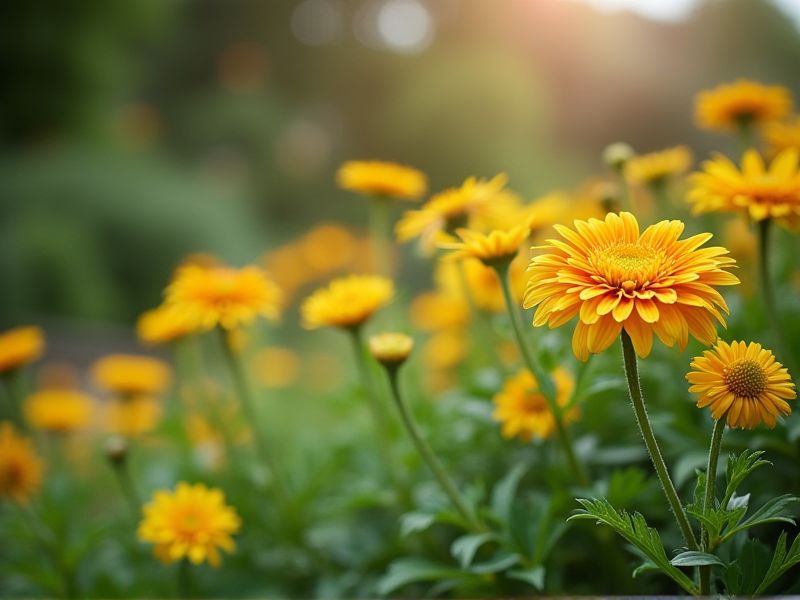
Perennial plants such as lady's mantle (Alchemilla mollis), sedum (Sedum spp.), and coneflower (Echinacea purpurea) thrive in various climates and offer vibrant flowers year after year. These low-maintenance varieties typically require minimal watering once established, making them ideal for busy gardeners or those seeking sustainable landscaping options. The resilience of perennials means they can endure harsh weather conditions while providing habitat for pollinators like bees and butterflies. Incorporating these plants into your garden ensures a burst of color with minimal effort, creating a stunning backdrop throughout the seasons. Native perennial species also contribute to local biodiversity, enhancing overall ecosystem health.
List of some Perennial plants that require little care
- Lavender (Lavandula)
- Coneflower (Echinacea)
- Daylily (Hemerocallis)
- Hostas (Hosta)
- Yarrow (Achillea)
- Sedum (Sedum)
- Russian Sage (Perovskia atriplicifolia)
- Ornamental Grass (Miscanthus)
- Catmint (Nepeta)
- Black-eyed Susan (Rudbeckia)
Important things about Perennial plants that require little care
Low Maintenance Requirements
Perennial plants are an ideal choice for gardeners seeking low-maintenance options that enhance outdoor spaces with beauty and resilience. Varieties such as sedum, daylilies, and coneflowers thrive in various conditions while demanding minimal attention, allowing you to enjoy a vibrant garden without extensive care. Many of these hardy perennials are drought-resistant, attracting pollinators and adding color year after year. Selecting the right low-maintenance perennials can transform your garden into a flourishing ecosystem that beautifies your landscape effortlessly.
Drought Tolerance
Perennial plants, known for their longevity and resilience, often exhibit remarkable drought tolerance, making them ideal for low-care gardens. Varieties such as Agastache, Echinacea, and Sedum are well-suited for arid environments, thriving with minimal water input once established. These drought-tolerant perennials not only reduce irrigation needs but also attract pollinators, contributing to a vibrant ecosystem in your garden. Implementing these hardy plants can simplify garden maintenance while promoting environmental sustainability.
Long Lifespan
Perennial plants, known for their longevity and resilience, can be an excellent addition to low-maintenance gardens. These plants, such as daylilies (Hemerocallis), hostas, and lavender (Lavandula), thrive in various climates and soil types, making them versatile choices for gardeners. Once established, perennial plants often return year after year, providing color and texture with minimal effort. To ensure their health, simply consider planting them in well-draining soil and providing occasional watering during dry spells.
Seasonal Beauty
Perennial plants, such as lavender, hostas, and daylilies, offer stunning seasonal beauty with minimal maintenance. These hardy plants return year after year, flourishing in a variety of environments and adapting well to local climates. Low-care varieties like sedum and coneflower are perfect for busy gardeners, providing vibrant blooms and lush foliage without the need for constant watering or pruning. Incorporating these resilient perennials into your landscape not only enhances its aesthetic appeal but also supports local ecosystems by attracting pollinators and beneficial insects.
Soil Adaptability
Perennial plants are remarkably versatile, thriving in various soil types, including sandy, clay, and loamy soils, which allows them to adapt to different environmental conditions. These low-maintenance species, such as lavender and sedum, require minimal care once established, making them ideal for busy gardeners or those who prefer a hands-off approach. Furthermore, the deep-root systems of many perennials enhance soil structure and promote water retention, reducing erosion and supporting soil health. By selecting the right perennial plants for your garden, you can enjoy a vibrant landscape with minimal effort, while also contributing to ecological balance.
Natural Pest Resistance
Perennial plants, such as lavender, echinacea, and bee balm, exhibit natural pest resistance, making them ideal for low-maintenance gardens. These plants produce essential oils and compounds that deter unwanted insects, reducing the need for chemical pesticides. By incorporating these resilient varieties, you can cultivate a thriving garden that attracts beneficial pollinators while minimizing pest issues. The ability of perennials to return year after year enhances your landscape with vibrant colors and textures, further promoting ecological balance in your outdoor space.
Attract Beneficial Wildlife
Perennial plants that thrive with minimal maintenance are ideal for attracting beneficial wildlife, such as butterflies, bees, and other pollinators. Native perennials like coneflowers, black-eyed Susans, and asters provide essential nectar and habitat, fostering a vibrant ecosystem in your garden. These hardy plants often require little more than occasional watering and deadheading, making them perfect for busy gardeners. By incorporating these low-maintenance perennials into your landscape, you can enhance biodiversity and support local wildlife while enjoying a beautiful, colorful display year after year.
Versatile Landscaping Uses
Perennial plants are an excellent choice for low-maintenance landscaping, thriving year after year with minimal intervention. Varieties such as Echinacea, Sedum, and Daylilies not only enhance the aesthetic appeal of your garden but also attract beneficial pollinators like bees and butterflies. Their resilience allows them to withstand varying weather conditions, making them ideal for diverse climates. By incorporating these hardy perennials into your landscape, you can enjoy a vibrant and sustainable garden without the need for constant upkeep.
Minimal Fertilization Needs
Perennial plants, such as lavender, sedum, and daylilies, thrive with minimal fertilization and care, making them ideal for low-maintenance gardens. These hardy species often develop deep root systems that enable them to access nutrients from the soil effectively, reducing the need for regular feeding. Selecting drought-resistant varieties can further minimize your gardening efforts, as they withstand dry conditions while maintaining vibrant growth. By choosing such perennials, you can create a beautiful, sustainable landscape that requires less attention over time.
Self-Seeding Potential
Perennial plants that self-seed offer a sustainable gardening solution for those seeking low-maintenance options. Varieties such as coneflowers and black-eyed Susans not only flourish year after year but also spread their seeds, creating a vibrant garden with minimal effort. Native perennials like milkweed and butterfly bush attract pollinators, enhancing biodiversity while requiring little care once established. By incorporating self-seeding perennials into your garden, you can create a beautiful landscape that thrives with minimal intervention and supports local ecosystems.
